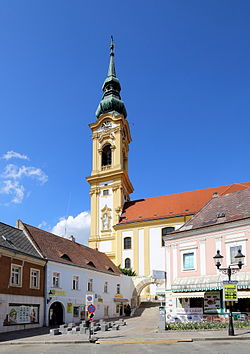Burg Greifenstein
Austrian castle stubsCastles in Lower AustriaLower Austria geography stubs

Burg Greifenstein is a castle in Lower Austria, Austria, overlooking the Danube. Burg Greifenstein is 227 metres (745 ft) above sea level. Approximately opposite to Burg Greifenstein is Burg Kreuzenstein, on the north shore of the Danube.
Excerpt from the Wikipedia article Burg Greifenstein (License: CC BY-SA 3.0, Authors, Images).Burg Greifenstein
Hauptstraße, Gemeinde St. Andrä-Wördern
Geographical coordinates (GPS) Address Website Nearby Places Show on map
Geographical coordinates (GPS)
| Latitude | Longitude |
|---|---|
| N 48.3494444444 ° | E 16.2544444444 ° |
Address
Karner
Hauptstraße
3423 Gemeinde St. Andrä-Wördern
Lower Austria, Austria
Open on Google Maps









